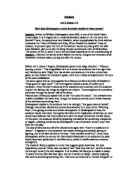The intense dialogue between Macbeth and Lady Macbeth reveals information about the dynamic of their relationship. In this scene there seems to be a gender role reversal to the couple; Macbeth appears to be feminine in his worrying and outward showing of guilt while his wife remains detached and cool, only showing guilt subconsciously. This change of gender is surprising to the audience due to the fact that when this play was produced, women were not permitted to speak up for themselves or show leadership. “To know my deed, 'twere best not know myself.” This obscure line is an answer to Lady Macbeth's reproach that he is "poorly lost" in his thoughts. Macbeth says in effect that he had better remain lost, "not know myself," than awake to a full realization of what he had done, "know my deed." This shows the audience that Macbeth is weak, distressed and unable to forgive himself and brings dramatic tension to the scene.
Tension is also created through the stagecraft of this scene. In this scene Shakespeare uses blood to bring a brutal murderous atmosphere into the play. Macbeth carries two bloody daggers onto the stage after he has committed the murder of king Duncan, “Enter Macbeth (with two bloody daggers)” The daggers and Macbeth’s bloody hands symbolise death and are the very visual sign of his guilt. However, although Macbeth has committed a ferocious murder, he is filled with remorse and this brings the audience to doubt his fault. The audience is pulled apart by two contrasting emotions; not sure whether to pity Macbeth or wish him caught.
Lady Macbeth runs on and off stage continuously creating a frantic atmosphere. At Lady Macbeth’s first departure off stage, knocking begins. This creates dramatic tension because the audience feels the panic and distress of Macbeth. The knocking begins shortly after the murder has been committed and Lady Macbeth has gone. This contributes to the panic and distress of Macbeth because he fears that the knocking means that the murder has been discovered already. Macbeth is petrified of not only being discovered, but also of the punishments god might have in mind for him. Having Lady Macbeth leave the stage just before the knocking makes Macbeth even more terrified because he is alone with this distress and uncertainty, he doesn’t have Lady Macbeth to assure him that all is well. “How is’t with me, when every noise appals me?” Every noise, every movement alarms him; he does not have the control that Lady Macbeth does. It is this lack of control that brings dramatic tension to this scene because Macbeth’s actions might expose their guilt.
Shakespeare uses anxious utterances and questions to increase the tension in Act 2, scene 2. An example of this is, “when?” and “as I descended?” This enhances the curiosity of the audience; they desire to know whether or not Macbeth has committed the murder. Macbeth seems lost and intimidated; his wife compels him. Macbeth is anxious and confused. The use of questions expresses uncertainty and agitation creating dramatic tension. As well as questions and utterances, Shakespeare also uses violent emotive semantic fields to amplify the brutality of the story, “Go carry them and smear/The sleepy grooms with blood.” The guards wouldn’t be covered in blood if they had committed the murder; they would have washed it off with water. This brings excitement and adrenaline to the audience and creates dramatic tension.
Not only has Shakespeare chosen to use stagecraft and language to embrace tension in this scene, he also uses imagery. One example is, “It was the owl that shrieked, the fatal bellman which gives the stern’st goodnight.” Shakespeare refers to the owl as the "fatal bellman" because it was the bellman's job to ring the parish bell when a person in the town was to be executed. Since king Duncan is murdered, this brings irony and tension into the piece. In this scene, Macbeth says, “Glamis hath murdered sleep, and therefore Cawdor shall sleep no more.” Macbeth has murdered sleep and therefore he won’t be able to sleep anymore. Shakespeare uses the term “murdered sleep” because it relates well to this scene. Macbeth has killed Duncan in his sleep and in this act he managed to kill everything that was ever good in him; sleep being the only innocent left in him. The audience don’t know if they want Macbeth captured or not, this creates a tense and bewildered atmosphere.
In conclusion Act 2, scene 2 is filled with tension and suspense. In the end of this scene, the audience are left with mixed emotions; unsure if they are to feel sympathy for Macbeth or if they should loathe him for his dirty deed. The audience are left in a state of anxiety and anticipation, dying to know what will happen next. Expectations should be widely spread across the room, the spectators suspecting the worst consequences for Lady Macbeth and Macbeth. In the end of this scene, Lady Macbeth rushes off stage, where Macbeth quickly follows muttering to himself, wishing king Duncan would return to life, “Wake Duncan with thy knocking: I would thou couldst.” Macbeth regrets committing the murder and wishes he could bring him back to life. These final words in this scene leave the audience hanging in a state of tension.
Kezia Kristine Krog 10 Palm








